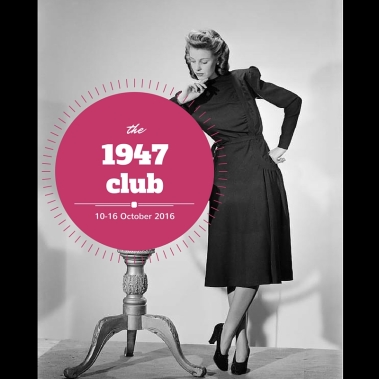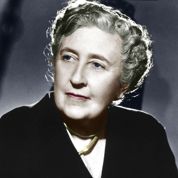Yes, today is the first day of our wonderful week of reading books from the year 1947 – part of a series cleverly thought up by my co-host Simon at Stuck-in-a-Book. So far we’ve covered books from 1924 and 1938, and had some fabulous reading experiences. However, 1947 looks to be a vintage year for publishing, and I’m starting off the week in style! I’ve also put up a separate page for 1947 and if you read or review anything from that year do leave a comment and I’ll do my best to include everyone!
I was personally really pleased to find out that Agatha Christie’s “The Labours of Hercules” was one of the books published in 1947, as I have happy memories of reading it as a teenager, and I thought it was definitely due a revisit. By the time of its publication, Christie had been a household name for decades as was Poirot himself; and this collection of linked short stories is presented under the conceit that Poirot will take on 12 cases mirroring the historical Labours of Hercules before he finally retires. Of course, we know now that the determined detective would carry on solving crimes until his creator’s death in the 1970s, but at the time the thought of Poirot retiring must have shocked his readers as much as the death of Sherlock Holmes on the Reichenbach Falls did!
There is a foreword where Poirot dines with an academic friend and laments he never studied the classics. It is this friend, Dr. Burton, who mentions in passing the classic Labours and laughingly refers to Poirot’s inappropriate forename, thereby triggering the whole concept of the book. The stories that follow are a wonderfully varied bunch, tied loosely to each Labour, and even if you have no classical knowledge (and I don’t!) they’re absolutely brilliant and immensely enjoyable.
So for example, “The Nemean Lion” has Poirot looking into the kidnapping of Pekinese dogs, an apparently trivial crime that turns out to have hidden repercussions. “The Lernaean Hydra” deals with murder and poison pen letters (the latter one of Christie’s regular tropes) in a small village. “The Stymphalean Birds” has fraud and potential blackmail, and warns of the dangers to foolish Englishmen who travel abroad without knowing any other languages! “The Cretan Bull” features hereditary madness, and “The Capture of Cerberus” reunites Poirot with Countess Vera Rossakoff in a post-War London setting. The latter was always one of my favourites, with the opening scenes of Poirot being jostled in the London Tube and encountering the Countess on a huge escalator permanently stuck in my mind. These are just some of the highlights; really, each of the varied stories is a little gem and I don’t want to pick favourites! Inspector Japp and Poirot’s valet Georges make an appearance or two, as does Miss Lemon, who is always a joy!
And Poirot ranges far and wide whilst undertaking his Labours, travelling all over the world and meeting a variety of different people, all the while using his ingenious methods of discovering the truth and dispensing his own kind of justice (as we see in many of his stories). There is a surprising amount of drug-taking featured (cocaine and the like, not just poisons being used for murders) and Christie has a wonderfully no-nonsense approach to life. In fact, it’s a delight to rediscover how much she used sly humour to dig at the rich and silly. There isn’t a titled lady with a Pekinese who gets off lightly, nor a pompous lord or businessman having an affair with a secretary who isn’t deflated or warned off. Agatha Christie and Hercule Poirot are on the side of the governesses, companions and car mechanics, and it’s lovely. That’s not to say that the cases don’t deal with some richer people from the upper echelons – they do, which is proof that Christie can see good in all. Some of her descriptions are just priceless, like this one of a rather alarming country home:
Inside, it was what a house agent would have described as “fully furnished”. Cross-legged Buddhas leered down from convenient niches, brass Benares trays and tables encumbered the floor space. Processional elephants garnished the mantelpieces and more tortured brass work adorned the walls.
If I had to stand back and be truly honest, there *are* times when Christie rather stretches things to fit in with her concept; taking Poirot to the top of a Swiss mountain to deal with dangerous gangsters is perhaps – well, unexpected. But none of this detracts from reading Christie at the height of her powers, and the book is pure joy and entertainment. There are a couple of sly nods to Sherlock Holmes, as if to acknowledge the debt all Golden Age crime writers owed to Conan Doyle (particularly in a partnership structured like Poirot and Hastings), as well as mentions of Reggie Fortune and Sir Henry Merrivale, some of Poirot’s contemporaries.
So my first book for the 1947 Club has turned out to be a fabulous one and a real pleasure. I forget how much I love Christie when I leave a gap between books, but revisiting “The Labours of Hercules” has convinced me that when I have the time (retirement maybe!) I shall sit down and read the entirety of her output from start to finish in chronological order!









Oct 10, 2016 @ 06:38:48
Sounds great fun 🙂 Lovely edition too, I do enjoy a Pan paperback!
Oct 10, 2016 @ 09:27:02
It was a joy to read!
Oct 10, 2016 @ 09:13:33
Has anyone mentioned PERSEPHONE THE BLANK WALL–Elizabeth Sanxay Holding?
Oct 10, 2016 @ 09:26:25
That’s a good one!
Oct 11, 2016 @ 10:11:28
As a Persephone it should have been mentioned first.(!)THE BLANK WALL.
Oct 11, 2016 @ 11:50:06
Yes, that’s another good one!
Oct 10, 2016 @ 09:15:18
And OF LOVE AND HUNGER by Julian Maclaren Ross also published 1947.
Oct 10, 2016 @ 09:26:32
And so is that!
Oct 10, 2016 @ 13:34:21
I have dim ideas that I read this as a teenager… but it must be time for a re-read!
Oct 10, 2016 @ 14:35:28
Absolutely! It’s a joy! At some time in my life, I’ve read everything Christie mystery but I still love going back to them over and over.
Oct 11, 2016 @ 10:10:25
“OF LOVE AND HUNGER “is so good i have read it twice in a year and heard the BOOK AT BEDTIME version–currently on RADIO4EXTRA IPLAYER.I think Patrick Hamilton was envious of it.
Oct 11, 2016 @ 11:50:26
It’s a great book – I reviewed it on here and will get round to linking to that eventually!
Oct 10, 2016 @ 16:08:26
That sounds great! I read all of the novels as a teenager but really can’t remember that one!
Oct 10, 2016 @ 16:10:16
It’s great fun, and one of the ones I remember from my teens because I loved the scene in the underground!
Oct 10, 2016 @ 16:43:16
How wonderful that your 1947 week started off so well. I, too, always forget how much I enjoy Agatha Christie, since I don’t read her nearly enough. I did see that my library just added a few audiobooks of her to its catalog, so I’m thinking I’ll try them out in November. Gray commutes will be much brighter with a good mystery going.
Oct 10, 2016 @ 17:51:59
Ooh I do love a bit of Dame Agatha, absolutely years since I read this one.
I have just finished reading In a Lonely Place by Dorothy B Hughes. Brilliant stuff. Hopefully will get a review up mid-week. Now moving on to One Fine Day by Mollie Panter-Downes.
Oct 10, 2016 @ 21:33:43
You can’t go wrong with Agatha, in my view! Look forward to your thoughts on the Hughes and One Fine Day – I loved that book!
Oct 10, 2016 @ 20:23:23
I sometimes feel that I’m the only person who doesn’t like whodunits, crime novels, thrillers etc. Having said that I do want to read something by Christie at some point in my life. This one perhaps?
Oct 10, 2016 @ 21:33:08
Each to his own – it would be dull if we all liked the same stuff! I’m not sure if this is really the best way to start with Christie – maybe “The Murder of Roger Ackroyd”?
Oct 10, 2016 @ 21:18:26
I’ve just finished reading this and will be posting my review later in the week. I’m not usually a fan of short story collections but I did enjoy this one!
Oct 10, 2016 @ 21:30:19
It’s great fun, isn’t it? Look forward to your thoughts!
Oct 12, 2016 @ 12:23:28
No, no, no you cannot do this – take me off my plan to finish Elizabeth Taylor in order to read Christie 🙂
it does sound far fetched to put Poirot on a mountain top – his spats will never manage to hold him up if its snowy and the moustache is bound to curl in the cold air
Oct 12, 2016 @ 15:55:56
🙂 But reading Dame Agatha is always so tempting…. And though Poirot on the Alps is a little unexpected, she’s such a readable writer!
Oct 12, 2016 @ 18:55:59
I have joined! https://gubbinal.com/2016/10/12/the-1947-club-the-fall-of-the-magicians-by-weldon-kees/
It’s a different genre, but I hope that I can be a member of the club.
Oct 12, 2016 @ 19:04:32
Anyone can join! Genre doesn’t matter as long as the book is from 1947. Glad you can take part and I’ll link to your post!
Oct 13, 2016 @ 02:10:02
Karen, I’m so crazily behind that I was about to start reading Count Belisarius (1938) and… I will try to find something very short and 1947ish.
Well done! I love Christie and Philip Larkin. And now over and out…
Oct 13, 2016 @ 09:21:42
Well, 1938 is a good year too….. 😉
1947 Club and RIP Book 2 | ravenscroftcloud
Oct 15, 2016 @ 04:16:14
The #1947Club is here! – Stuck in a Book
Oct 15, 2016 @ 22:21:02
Oct 16, 2016 @ 23:59:42
The Middle of the Journey by Lionel Trilling: https://corvuscornix.wordpress.com/2016/10/16/the-middle-of-the-journey-by-lionel-trilling-1947-club/
A Dolls’ House by Rumer Godden: https://corvuscornix.wordpress.com/2016/10/16/a-dolls-house-by-rumer-godden-1947-club/
Oct 17, 2016 @ 17:24:19
Thank yo – I’ll add links!